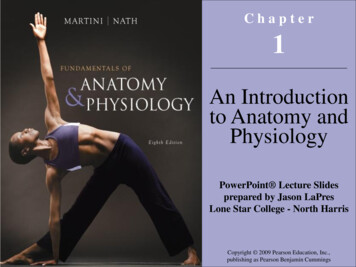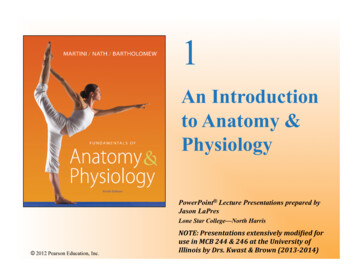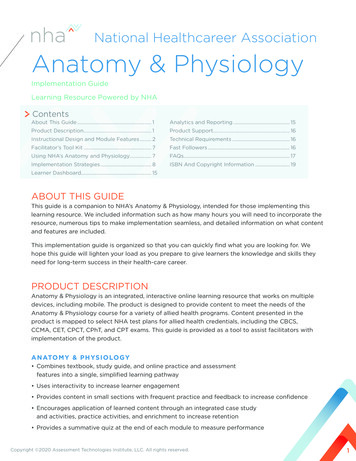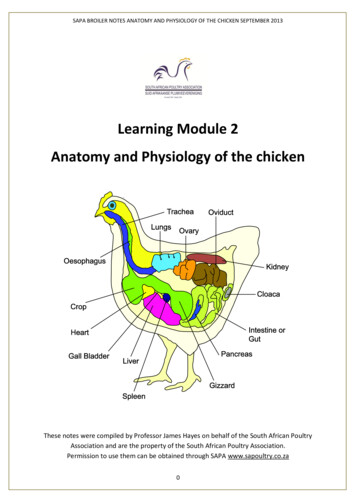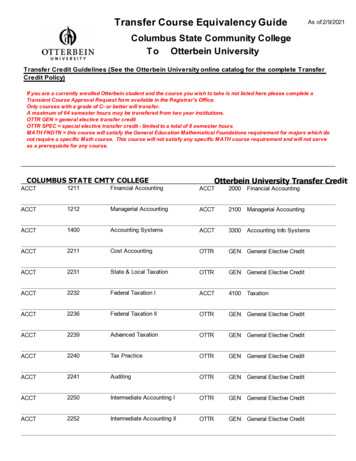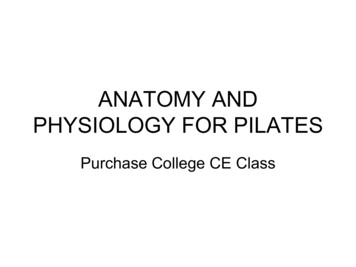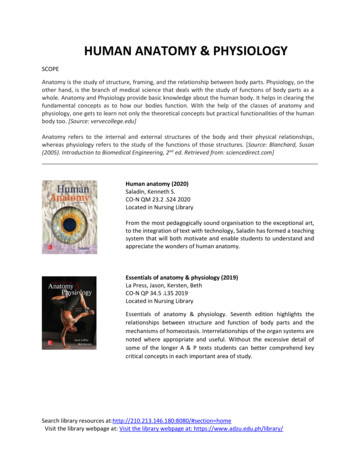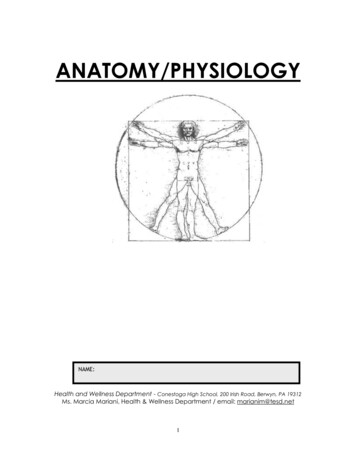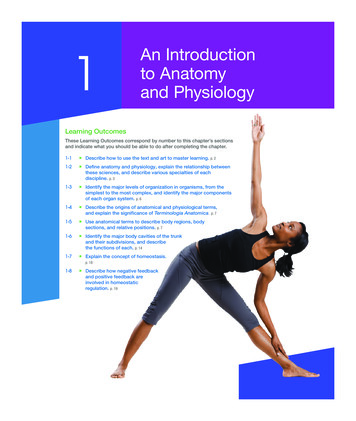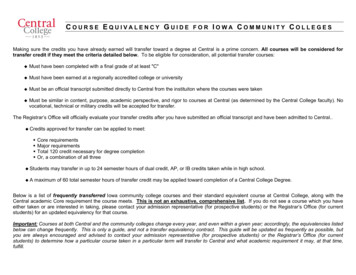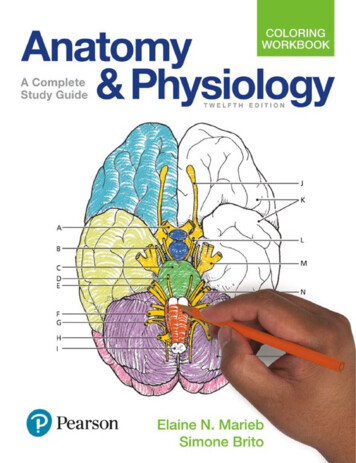
Transcription
ANATOMY & PHYSIOLOGY COLORING WORKBOOKA Complete Study GuideTWELFTH EDITIONElaine N. Marieb, R.N., Ph.D.Holyoke Community CollegeSimone Brito, M.S.Fresno City College330 Hudson Street, NY, NY 10013
Courseware Portfolio Manager: Lauren HarpContent Producer: Susan MalloyManaging Producer: Nancy TaborCourseware Director, Content Development: Barbara YienCourseware Editorial Assistant: Nicky Montalvo RomanoFull-Service Vendor: iEnergizer Aptara, LtdSenior Project Manager: Kelly RicciCopyeditor: Jenifer F. WalkerCompositor: iEnergizer Aptara, LtdDesign Manager: Mark OngCover Designer: Gary Hespenheide DesignCover Photo Credit: Rueangwit Sawangkaew/iStock/Getty ImagesIllustrators: ImagineeringArt.com Inc.Manufacturing Buyer: Stacey WeinbergerExecutive Marketing Manager: Allison RonaCopyright 2018, 2015, 2012, 2009 Pearson Education, Inc. All Rights Reserved. Printed in theUnited States of America. This publication is protected by copyright, and permission should beobtained from the publisher prior to any prohibited reproduction, storage in a retrieval system,or transmission in any form or by any means, electronic, mechanical, photocopying, recording,or otherwise. For information regarding permissions, request forms and the appropriate contacts within the Pearson Education Global Rights & Permissions department, please hered.comISBN 10: 0-134-45936-9 (Student edition)ISBN 13: 978-0-134-45936-3 (Student edition)1 17
PREFACEAlthough never a simple task, the study of the human body is always fascinating.Over the years, thousands of students have benefited in their studies and enjoyedthe process of working through this book. Whether you are taking a one- ortwo-semester course, you will find this book invaluable to the study of anatomyand physiology.What’s New to This Edition?The twelfth edition of the Anatomy & Physiology Coloring Workbook continuesto serve as a review and reinforcement tool to help health professional and lifescience students master the basic concepts of human anatomy and physiology.We have helped students by making the following revisions:New crossword puzzle exercises have been added to every chapter.New streamlined presentation of exercises has been created.Updated terminology has been added throughout the book.Seventeen figures have been revised.New figure illustrating the skeletal muscle has been added. New exercise and figure illustrating the blood flow through the hearthave been added. New groupings of terms have been added to the elimination-type exercises. Direct instructions for coloring exercises were introduced, replacing “as youwish” coloring sections. ScopeAlthough this book reviews the human body from microscopic to macroscopiclevels (that is, topics range from simple chemistry and cells to body organsystems), it is not intended to be encyclopedic. In fact, to facilitate learning, thisworkbook covers only the most important and useful aspects of human anatomyand physiology. Pathophysiology is briefly introduced with each system so thatstudents can apply their learning. Where relevant, clinical aspects (for example,muscles used for injection sites, the role of ciliated cells in protection of the respiratory tract, and reasons for skin ulcer formation) are covered. To encourage aview of the human body as a dynamic and continually changing organism, developmental aspects of youth, adulthood, and old age are included.Learning AidsAs in previous editions, multiple pedagogical devices are used throughout thebook to test comprehension of key concepts. The integration of a traditionalstudy guide approach with visualization and coloring exercises is unique. Thevariety of exercises demands learning on several levels, avoids rote memoriza tion, and helps maintain a high level of interest.iii
iv Anatomy & Physiology Coloring WorkbookThe exercises include completion from a selection of key choices, matching termsor descriptions, and labeling diagrams. Elimination questions require the studentto discover the similarities or dissimilarities among a number of structures orobjects and to select the one that is not appropriate. Correctable true/false questions add a new dimension to the more traditional form of this exercise. Also,students are asked to provide important definitions. In the completion sections,the answer lines are long enough so that the student can write in either the keyletter or the appropriate term. Both responses are provided in the answer section.Coloring exercises are a proven motivating, effective approach to learning. Eachillustration has been carefully prepared to show sufficient detail for learning without students becoming bored with coloring. There are more than 120 coloringexercises distributed throughout the text that should prove valuable to allstudents. Students who are visually oriented will find these exercises particularlybeneficial. When completed, the color diagrams provide an ideal reference andreview tool.At least one crossword puzzle is found within each chapter of this book. Thesecrossword puzzle exercises were created to increase student learning in a newand fun way.Visualization exercises are a truly unique feature of this book. With the exceptionof the introductory chapter on terminology, each chapter contains an “ IncredibleJourney.” Students are asked to imagine themselves in miniature, traveling withinthe body through various organs and systems. These visualization exercises areoptional, but they often summarize chapter content, allowing students to assimilate what they have learned in unusual and amusing ways.Thought-provoking “At the Clinic” ques tions challenge students to apply theirnewly acquired knowledge to clinical situations. Additionally, the twelfth editionfeatures a finale to each chapter with challenging multiple-choice questions.AcknowledgmentsTo those educators, colleagues, and students who have provided feedback andsuggestions during the preparation of all twelve editions of this workbook, we are sincerely grateful. In particular, we want to thank the following reviewers for theirvaluable comments and suggestions: Laura Bianco (Delaware Technical Community College), Allen Crooker (Hartwick College), Jackie Hedgpeth (Everett Community College), Sara Kalifa (Northern Virginia Community College), Karen Martin(Fulton Montgomery Community College), Kathy Monroe (Blue Ridge Communityand Technical College), Laura Ritt (Burlington County College), Trish Sevene (CSUMonterey Bay), and Laura Sweet (Eastern Michigan University). For this edition,special thanks to Joshua Parker, Fresno City College; and Patricia Mote and JannaBlum, Georgia State University—Perimeter College.The staff at Pearson Education has continuously supported our efforts to turnout a study tool that will be well-received and beneficial to both educator andstudent audiences. For this edition, Kelly Ricci at Aptara and Susan Malloy,Brooke Suchomel, and Tiffany Mok at Pearson Education deserve special mention.
INSTRUCTIONS FOR THE STUDENT—HOW TO USE THIS BOOKDear Student,The Anatomy & Physiology Coloring Workbook has been created particularly foryou. It is the outcome of years of personal attempts to find and create exerciseshelpful to our own students when they study and review for a lecture test or laboratory quiz.We never cease to be amazed by how remarkable the human body is, but wewould never try to convince you that studying it is easy and, like learning a newlanguage, it requires a lot of dedication. The study of human anatomy and physiology has its own special terminology. It also requires that you become familiarwith the basic concepts of chemistry to understand physiology, and often (sadly)it requires rote memorization of facts. It is our hope that this workbook will helpsimplify your task. To make the most of the exercises, read these instructionscarefully before starting work.Labeling and Coloring. Some of these questions ask you only to label a diagram, but most also ask that you do some coloring of the figure. You can usually choose whichever colors you prefer. Soft-colored pencils are recommendedso that the underlying diagram shows through. Most figures have several parts tocolor, so you will need a variety of colors—18 should be sufficient. In the coloring exercises, you are asked to choose a particular color for each structure to becolored. That color is then used to fill in both a color-coding circle found next tothe name of the structure or organ, and the structure or organ on the figure. Thisallows you to identify the colored structure quickly and by name in cases wherethe diagram is not labeled. In a few cases, you are given specific coloring instructions to follow.Matching. Here, you are asked to match a key term denoting a structure or physiological process with a descriptive phrase or sentence. Because you mustwrite the chosen term in the appropriate answer blank, the learning is moreenduring.Completion. You select the correct term to answer a specific question, or youfill in blanks to complete a sentence. In many exercises, some terms are usedmore than once and others are not used at all.Definitions. You are asked to provide a brief definition of a particular structureor process.True or False. One word or phrase is underlined in a sentence. You decide if thesentence is true as it is written. If not, you correct the underlined word or phrase.v
vi Anatomy & Physiology Coloring WorkbookElimination. Here, you are asked to find the term that does not “belong” in aparticular grouping of related terms. You will also have to identify a key word,or in some cases a phrase, that the remaining terms have in common and thatdefines them as a group. In this type of exercise, you must analyze how the various terms are similar to or different from the others.Crossword Puzzle. Here, you fill in the crossword puzzle with one or twowords from the key choices that answer each clue. In some exercises, morechoices than clues are provided. When the answer to a puzzle is composed oftwo words, the words are used in the puzzle without a space.Visualization. The “Incredible Journey” is a special type of completionexercise, found in every chapter except the first one. For this exercise, you areasked to imagine that you have been miniaturized and injected into the body of ahuman being (your host). Anatomical landmarks and physiological events aredescribed from your miniaturized viewpoint, and you are then asked to identifyyour observations. Although this exercise is optional, our students have foundthem fun to complete and we hope you will too.At the Clinic. “At the Clinic” sections ask you to apply your newly acquiredknowledge to clinical situations.The Finale: Multiple Choice. The multiple-choice questions test you fromseveral vantage points, and 1, 2, 3, or all of the answers may be correct—anapproach that really tests your understanding of what you have studied.Each exercise has complete instructions, which you should read carefully beforebeginning the exercise. When there are multiple instructions, complete them inthe order given.At times, it may appear that information is duplicated in the different types ofexercises. Although there is some overlap, the understandings being tested aredifferent in the different exercises. Remember, when you understand a conceptfrom several different perspectives, you have mastered that concept.We sincerely hope that the Anatomy & Physiology Coloring Workbook challengesyou to increase your knowledge, comprehension, retention, and appreciation ofthe structure and function of the human body.Good luck!Elaine MariebPearson Education1301 Sansome StreetSan Francisco, CA 94111Simone BritoPearson Education1301 Sansome StreetSan Francisco, CA 94111
CONTENTSChapter 1 THE HUMAN BODY:AN ORIENTATION 1Chapter 5 THE SKELETALSYSTEM 75An Overview of Anatomy and Physiology 1Levels of Structural Organization 2Maintaining Life 7Homeostasis 8The Language of Anatomy 8Bones—An Overview 75Axial Skeleton 79Skull 79Vertebral Column 83Thoracic Cage 86Appendicular Skeleton 87Bone Fractures 96Joints 97Homeostatic Imbalances of Bones and Joints 99Developmental Aspects of the Skeleton 99At the Clinic 13The Finale: Multiple Choice 15Chapter 2 BASIC CHEMISTRY 17Concepts of Matter and Energy 17Composition of Matter 18Molecules, Chemical Bonds, and ChemicalReactions 20Biochemistry: The Composition of Living Matter 23Incredible Journey: A Visualization Exercisefor Biochemistry 28At the Clinic 30The Finale: Multiple Choice 31Chapter 3 CELLS AND TISSUES 33Cells 33Overview 33Anatomy of a Generalized Cell 34Cell Physiology 38Body Tissues 46Tissue Repair 51Developmental Aspects of Cells and Tissues 52Incredible Journey: A Visualization Exercisefor the Cell 53At the Clinic 54The Finale: Multiple Choice 56Chapter 4 SKIN AND BODY MEMBRANES 59Classification of Body Membranes 59Integumentary System (Skin) 61Basic Functions of the Skin 61Basic Structure of the Skin 62Appendages of the Skin 64Homeostatic Imbalances of the Skin 67Developmental Aspects of the Skin and BodyMembranes 68Incredible Journey: A Visualization Exercisefor the Skin 68At the Clinic 70The Finale: Multiple Choice 72Incredible Journey: A Visualization Exercisefor the Skeletal System 100At the Clinic 101The Finale: Multiple Choice 103Chapter 6 THE MUSCULARSYSTEM 105Overview of Muscle Tissues 105Microscopic Anatomy of Skeletal Muscle 107Skeletal Muscle Activity 109Muscle Movements, Types, and Names 112Gross Anatomy of the Skeletal Muscles 114Muscles of the Head 114Muscles of the Trunk 116Muscles of the Hip, Thigh, and Leg 120Muscles of the Arm and Forearm 122General Body Muscle Review 123Developmental Aspects of the Muscular System 128Incredible Journey: A Visualization Exercisefor the Muscular System 128At the Clinic 129The Finale: Multiple Choice 131Chapter 7 THE NERVOUSSYSTEM 133Organization of the Nervous System 134Nervous Tissue—Structure and Function 134Central Nervous System 141Brain 141Protection of the CNS 147Brain Dysfunctions 148Spinal Cord 149Peripheral Nervous System 152Structure of a Nerve 152Cranial Nerves 153vii
viii Anatomy & Physiology Coloring WorkbookSpinal Nerves and Nerve Plexuses 154Autonomic Nervous System (ANS) 156Developmental Aspects of the NervousSystem 158Incredible Journey: A Visualization Exercisefor the Nervous System 158At the Clinic 160The Finale: Multiple Choice 163Chapter 8 SPECIAL SENSES 165The Eye and Vision 165The Ear: Hearing and Balance 170Chemical Senses: Smell and Taste 174Developmental Aspects of the SpecialSenses 177Incredible Journey: A Visualization Exercisefor the Special Senses 178At the Clinic 179The Finale: Multiple Choice 181Chapter 9 THE ENDOCRINESYSTEM 183The Endocrine System and Hormone Function—An Overview 183The Major Endocrine Organs 185Other Hormone-Producing Tissuesand Organs 190Developmental Aspects of the EndocrineSystem 191Incredible Journey: A Visualization Exercise forthe Endocrine System 191At the Clinic 192The Finale: Multiple Choice 193Chapter 10 BLOOD 195Composition and Functions of Blood 195Hemostasis 200Blood Groups and Transfusions 201Developmental Aspects of Blood 201Incredible Journey: A Visualization Exercisefor the Blood 202At the Clinic 203The Finale: Multiple Choice 205Chapter 11 THE CARDIOVASCULARSYSTEM 207The Heart 207Anatomy of the Heart 207Physiology of the Heart 212Blood Vessels 214Microscopic Anatomy of BloodVessels 214Gross Anatomy of Blood Vessels 215Physiology of Circulation 225Developmental Aspects of the CardiovascularSystem 229Incredible Journey: A Visualization Exercise forthe Cardiovascular System 230At the Clinic 231The Finale: Multiple Choice 234Chapter 12 THE LYMPHATIC S YSTEMAND BODY DEFENSES 237The Lymphatic System 237Lymphatic Vessels 237Lymph Nodes and Other LymphoidOrgans 239Body Defenses 242Nonspecific (Innate) Body Defenses 242Specific (Adaptive) Body Defenses: The ImmuneSystem 245Disorders of Immunity 254Developmental Aspects of the LymphaticSystem and Body Defenses 254Incredible Journey: A Visualization Exercise forthe Immune System 255At the Clinic 257The Finale: Multiple Choice 259Chapter 13 THE RESPIRATORYSYSTEM 261Functional Anatomy of the RespiratorySystem 261Respiratory Physiology 269Respiratory Disorders 273Developmental Aspects of the RespiratorySystem 274Incredible Journey: A Visualization Exercise forthe Respiratory System 274At the Clinic 276The Finale: Multiple Choice 277Chapter 14 THE DIGESTIVE SYSTEM ANDBODY METABOLISM 279Anatomy of the Digestive System 279Physiology of the Digestive System 291Nutrition and Metabolism 295Nutrients Used by Body Cells 295Metabolic Processes 296Developmental Aspects of the DigestiveSystem 300Incredible Journey: A Visualization Exercisefor the Digestive System 301At the Clinic 302The Finale: Multiple Choice 304Chapter 15 THE URINARYSYSTEM 307Kidneys 308Location and Structure 308Nephrons, Urine Formation, and Controlof Blood Composition 310Ureters, Urinary Bladder, and Urethra 315Fluid, Electrolyte, and Acid-Base Balance 317Developmental Aspects of the Urinary System 320
Anatomy & Physiology Coloring Workbook ixIncredible Journey: A Visualization Exercisefor the Urinary System 320At the Clinic 322The Finale: Multiple Choice 323Chapter 16 THE REPRODUCTIVESYSTEM 327Anatomy of the Male Reproductive System 327Male Reproductive Functions 330Anatomy of the Female Reproductive System 333Female Reproductive Functions and Cycles 335Mammary Glands 340Survey of Pregnancy and EmbryonicDevelopment 340Developmental Aspects of the ReproductiveSystem 345Incredible Journey: A Visualization Exercise forthe Reproductive System 346At the Clinic 348The Finale: Multiple Choice 350Answers 353
This page intentionally left blank
THE HUMANBODY: ANORIENTATION1Most of us have a natural curiosity about our bodies, and a study of anatomyand physiology elaborates on this interest. Anatomists have developed a univer sally acceptable set of reference terms that allows body structures to be locatedand identified with a high degree of clarity. Initially, students might have diffi culties with the language used to describe anatomy and physiology, but withoutsuch a special vocabulary, confusion is bound to occur.The topics in this chapter enable students to test their mastery of terminologycommonly used to describe the body and its various parts, and concepts con cerning functions vital for life and homeostasis. Body organization from simpleto complex levels and an introduction to the organ systems forming the bodyas a whole are also covered.AN OVERVIEW OF ANATOMY AND PHYSIOLOGY1. Match the terms in Column B to the appropriate descriptions providedin Column A. Enter the correct letter or its corresponding term in theanswer blanks.Column AColumn B1. The branch of biological science thatstudies and describes how body partswork or functionA. Anatomy2. The study of the shape and structureof body partsC. MetabolismB. HomeostasisD. Physiology3. The tendency of the body’s systems tomaintain a relatively constant or balancedinternal environment4. The term that indicates all chemicalreactions occurring in the body1
2 Anatomy & Physiology Coloring Workbook2. Use a highlighter to identify the terms or phrases that correctly relate to thestudy of physi ol ogy. Use a different color highlighter to identify those termsor phrases that relate to the study of anatomy. Color the coding circles. PhysiologyAnatomyA. Measuring an organ’s size, shape, and weightH. DynamicB. Can be studied in dead specimensI. DissectionC. Often studied in living subjectsJ. ExperimentationD. Chemistry principlesK. ObservationE. Measuring the acid content of the stomachL. Directional termsF. Principles of physicsM. StaticG. Observing a heart in actionLEVELS OF STRUCTURAL ORGANIZATION3. The structures of the body are organized into successively larger and morecomplex structures. Fill in the answer blanks with the correct terms forthese increasingly larger structures.ChemicalsOrganism4. Circle the term that does not belong in each of the following groupings.Then, fill in the answer blanks with the correct group name. Follow theexample below.E.g. Atom Cell Tissue Alive Organ Group: Levels of structural �� Epithelium Group:2.Epithelium3.Human Digestive system Horse Pine tree Amoeba Group:Heart Muscle tissue Nervous tissueConnective tissue Group:5. Using the key choices, complete the crossword puzzle by naming theorgan system that correctly answers each of the clues provided.Key ryLymphatic etalUrinary
Chapter 1 The Human Body: An Orientation 3Across1. Protects the body; destroys bacteria and tumor cells.4. Removes carbon dioxide from the blood.6. Rids the body of nitrogen-containing wastes; conserves body water or eliminates excesses.7. Includes the brain, nerves, and sensory receptors.8. Moves the limbs; allows facial expression.9. Provides support and levers on which the muscular system can act.10. Is affected by the removal of the thyroid gland.Down2. Delivers oxygen and nutrients to the body tissues.3. Protects underlying organs from drying out and from mechanical damage.4. Includes the testis, vas deferens, and urethra.5. Includes the esophagus, large intestine, and rectum.123456789106. Figures 1–1 to 1–6, on pages 4–6, represent the various body organ systems.Complete the following:(A) Identify and name each organ system by labeling the organ system undereach illustration.(B) Select a different color for each organ and use it to color the coding circlesand corresponding structures in the illustrations.
4 Anatomy & Physiology Coloring Workbook Blood vesselsHeart Nasal cavityLungsTracheaFigure 1–1Figure 1–2Organ System:Organ System:
Chapter 1 The Human Body: An Orientation 5 BrainSpinal cordNervesFigure 1–3Organ System:KidneysUretersBladderFigure 1–4Organ System:
6 Anatomy & Physiology Coloring Workbook StomachIntestinesEsophagusOral cavityFigure 1–5Organ System: OvariesUterusFigure 1–6Organ System:
Chapter 1 The Human Body: An Orientation 7MAINTAINING LIFE7. Match the terms that relate to functional characteristics of organisms inColumn B with the appropriate descriptions in Column A. Fill in the answerblanks with the appropriate letter or term.Column BColumn A1. Keeps the body’s internal environment distinct from the external environmentA. DigestionB. Excretion2. Provides new cells for growth and repair ata cellular levelC. Growth3. Occurs when constructive activities occurat a faster rate than destructive activitiesD. Maintenance ofboundaries4. The tuna sandwich you have just eaten isbroken down to its chemical building blocksE. Metabolism5. Elimination of carbon dioxide by the lungsand elimination of nitrogenous wastes bythe kidneysF. MovementG. ResponsivenessH. Reproduction6. Ability to react to stimuli; a major role ofthe nervous system7. Walking, throwing a ball, riding a bicycle8. All chemical reactions occurring in the body9. At the cellular level, membranes; for thewhole organism, the skin8. Using the key choices, correctly identify the survival needs that correspondto the following descriptions. Insert the correct letter or term in the answer blanks.Letters or terms can be used more than once.Key ChoicesA. Appropriate body temperatureB. Atmospheric pressureC. NutrientsD. OxygenE. Water1. Includes carbohydrates, proteins, fats, and minerals2. Essential for normal operation of the respiratory system andbreathing3. Single substance accounting for more than 60% of body weight4. Required for the release of energy from foodstuffs5. Provides the basis for body fluids of all types6. When too high or too low, physiological activities cease, primarilybecause molecules are destroyed or become nonfunctional
8 Anatomy & Physiology Coloring WorkbookHOMEOSTASIS9. The following statements refer to homeostatic control systems. Completeeach statement by inserting your answers in the answer blanks.1.2.3.4.5.6.7.There are three essential components of all homeostatic con trol mechanisms: control center, receptor, and effector. The(1) senses changes in the environment and responds bysending information (input) to the (2) along the (3)pathway. The (4) analyzes the input, determines the appropriate response, and activates the (5) by sending informa tion along the (6) pathway. When the response causes theinitial stimulus to decline, the homeostatic mechanism isreferred to as a (7) feedback mechanism. When theresponse enhances the initial stimulus, the mechanism iscalled a (8) feedback mechanism. (9) feedback mechan isms are much more common in the body.8.9.THE LANGUAGE OF ANATOMY10. Complete the following statements by filling in the answer blankswith the correct term.1.2.3.The abdominopelvic and thoracic cavities are subdivisions ofthe (1) body cavity; the cranial and spinal cavities are partsof the (2) body cavity. The (3) body cavity is totally surrounded by bone and provides very good protection to thestructures it contains.11. Circle the term or phrase that does not belong in each of the followinggroupings. Then, fill in the answer blanks with the correct group �� Sagittal �� Abdominal Popliteal Right iliac Left upper quadrant Group:5.Orbital cavity Nasal cavity Ventral cavity Oral cavity Group:
Chapter 1 The Human Body: An Orientation 912. Select different colors for the dorsal and ventral body cavities and color thecoding circles below. Complete the following in Figure 1–7:(A) Color the corresponding cavities in figure A.(B) Label the body cavity subdivisions that have a leader line in figure A.(C) Label each of the abdominal regions indicated by a leader line in figure B. Dorsal body cavity Ventral body cavityABFigure 1–7
10 Anatomy & Physiology Coloring Workbook13. Select the key choices that identify the following body parts or areas.Enter the appropriate letter or corresponding term in the answer blanks.Key lE.F.G.H.BuccalCervicalFemoralGlutealI. InguinalJ. LumbarK. OccipitalL. PoplitealM.N.O.P.PubicScapularSuralUmbilical1. Armpit2. Thigh region3. Buttock area4. Neck region5. “Belly button” area6. Genital area7. Anterior aspect of elbow8. Posterior aspect of head9. Area where trunk meets thigh10. Back area from ribs to hips11. Pertaining to the cheek14. Using the key terms from Exercise 13, correctly label all body areas indicatedwith leader lines on Figure 1–8.In addition, identify the sections labeled A and B in the figure.Section A:Section B:
Chapter 1 The Human Body: An Orientation 11ABAFigure 1–8B
12 Anatomy & Physiology Coloring Workbook15. From the key choices, select the body cavities and the cavity subdivisionwhere the following surgical procedures would occur. Insert the correctletter(s) or term(s) in the answer blanks. Be precise. Items may have morethan one answer.Key ChoicesA. AbdominalB. CranialC. DorsalD. PelvicE. SpinalF. ThoracicG. Ventral1. Removal of the uterus, or womb2. Coronary bypass surgery (heart surgery)3. Removal of a serious brain tumor4. Removal of a “hot” appendix5. A stomach ulcer operation16. Complete the following statements by choosing an anatomical term from thekey choices. Enter the appropriate letter or term in the answer blanks.Key ChoicesA. AnteriorB. DistalC. FrontalD. InferiorE. LateralF. Medial1.2.3.4.5.6.7.8.9.10.11.G. PosteriorH. ProximalI. SagittalJ. SuperiorK. TransverseIn the anatomical position, the face and palms are on the(1) body surface, the buttocks and shoulder blades are onthe (2) body surface, and the top of the head is the most(3) part of the body. The ears are (4) to the shouldersand (5) to the nose. The heart is (6) to the spine and(7) to the lungs. The elbow is (8) to the fingers but(9) to the shoulder. In humans, the dorsal surface can alsobe called the (10) surface; however, in four-legged animals,the dorsal surface is the (11) surface.
Chapter 1 The Human Body: An Orientation 1312.13.14.15.If an incision cuts the heart into right and left parts, the section is a (12) section, but if the heart is cut so that ante rior and posterior parts result, the section is a (13) section.You are told to cut an animal along two planes so that thepaired kidneys are observable in both sections. The two sections that meet this requirement are the (14) and (15)sections.17. Using the key choices, identify the body cavities where the following bodyorgans are located. Enter the appropriate letter or term in the answer blanks.Letters or terms can be used more than once.Key ChoicesA. AbdominopelvicB. CranialC. SpinalD. Thoracic1. Stomach7. Bladder2. Small intestine8. Trachea3. Large intestine9. Lungs4. Spleen10. Pituitary gland5. Liver11. Rectum6. Spinal cord12. Ovaries18. Number the following structures, from darkest (black) to lightest (white),as they would appear on an X-ray. Number the darkest one 1, the nextdarkest 2, etc. (Hint: Denser structures appear lighter).A. Soft tissueB. Femur (bone of the thigh)C. Air in lungsD. Gold (metal) filling in a toothAT THE C L INIC19. A jogger has stepped in a pothole and sprained his ankle. What organ systemshave suffered damage?
14 Anatomy & Physiology Coloring Workbook20. A newborn baby is unable to hold down any milk. Examination reveals adevelopmental disorder in which the esophagus fails to connect to the stom ach. What survival needs are most immediately threatened?21. The Chan family was traveling in their van and had a minor accident. Thechildren in the backseat were wearing lap belts, but they still
Although this book reviews the human body from microscopic to macroscopic levels (that is, topics range from simple chemistry and cells to body organ systems), it is not intended to be encyclopedic. In fact, to facilitate learning, this workbook covers only the most important and useful aspects of human anatomy and physiology.
